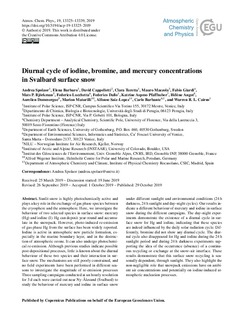| dc.contributor.author | Spolaor, Andrea | |
| dc.contributor.author | Barbaro, Elena | |
| dc.contributor.author | Cappelletti, David | |
| dc.contributor.author | Turetta, Clara | |
| dc.contributor.author | Mazzola, Mauro | |
| dc.contributor.author | Giardi, Fabio | |
| dc.contributor.author | Björkman, Mats P. | |
| dc.contributor.author | Lucchetta, Frederico | |
| dc.contributor.author | Pfaffhuber, Katrine Aspmo | |
| dc.contributor.author | Angot, Hélène | |
| dc.contributor.author | Dommergue, Aurelien | |
| dc.contributor.author | Maturilli, Marion | |
| dc.contributor.author | Saiz-Lopez, Alfonso | |
| dc.contributor.author | Barbante, Carlo | |
| dc.contributor.author | Cairns, Warren R. L. | |
| dc.date.accessioned | 2019-12-23T09:00:41Z | |
| dc.date.available | 2019-12-23T09:00:41Z | |
| dc.date.created | 2019-12-17T11:35:40Z | |
| dc.date.issued | 2019 | |
| dc.identifier.citation | Atmospheric Chemistry and Physics. 2019, 19 13325-13339. | nb_NO |
| dc.identifier.issn | 1680-7316 | |
| dc.identifier.uri | http://hdl.handle.net/11250/2634385 | |
| dc.description.abstract | Sunlit snow is highly photochemically active and plays a key role in the exchange of gas phase species between the cryosphere and the atmosphere. Here, we investigate the behaviour of two selected species in surface snow: mercury (Hg) and iodine (I). Hg can deposit year-round and accumulate in the snowpack. However, photo-induced re-emission of gas phase Hg from the surface has been widely reported. Iodine is active in atmospheric new particle formation, especially in the marine boundary layer, and in the destruction of atmospheric ozone. It can also undergo photochemical re-emission. Although previous studies indicate possible post-depositional processes, little is known about the diurnal behaviour of these two species and their interaction in surface snow. The mechanisms are still poorly constrained, and no field experiments have been performed in different seasons to investigate the magnitude of re-emission processes Three sampling campaigns conducted at an hourly resolution for 3 d each were carried out near Ny-Ålesund (Svalbard) to study the behaviour of mercury and iodine in surface snow under different sunlight and environmental conditions (24 h darkness, 24 h sunlight and day–night cycles). Our results indicate a different behaviour of mercury and iodine in surface snow during the different campaigns. The day–night experiments demonstrate the existence of a diurnal cycle in surface snow for Hg and iodine, indicating that these species are indeed influenced by the daily solar radiation cycle. Differently, bromine did not show any diurnal cycle. The diurnal cycle also disappeared for Hg and iodine during the 24 h sunlight period and during 24 h darkness experiments supporting the idea of the occurrence (absence) of a continuous recycling or exchange at the snow–air interface. These results demonstrate that this surface snow recycling is seasonally dependent, through sunlight. They also highlight the non-negligible role that snowpack emissions have on ambient air concentrations and potentially on iodine-induced atmospheric nucleation processes. | nb_NO |
| dc.language.iso | eng | nb_NO |
| dc.rights | Navngivelse 4.0 Internasjonal | * |
| dc.rights.uri | http://creativecommons.org/licenses/by/4.0/deed.no | * |
| dc.title | Diurnal cycle of iodine, bromine, and mercury concentrations in Svalbard surface snow | nb_NO |
| dc.type | Journal article | nb_NO |
| dc.type | Peer reviewed | nb_NO |
| dc.description.version | publishedVersion | nb_NO |
| dc.rights.holder | © Author(s) 2019. | nb_NO |
| dc.source.pagenumber | 13325-13339 | nb_NO |
| dc.source.volume | 19 | nb_NO |
| dc.source.journal | Atmospheric Chemistry and Physics | nb_NO |
| dc.identifier.doi | 10.5194/acp-19-13325-2019 | |
| dc.identifier.cristin | 1761790 | |
| dc.relation.project | EC/H2020/689443 | nb_NO |
| dc.relation.project | NILU: 110035 | |
| cristin.unitcode | 7460,60,0,0 | |
| cristin.unitname | Miljøkjemi | |
| cristin.ispublished | true | |
| cristin.fulltext | original | |
| cristin.qualitycode | 2 | |

